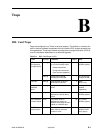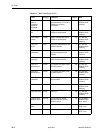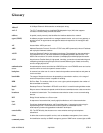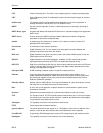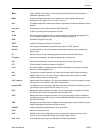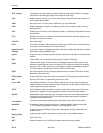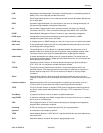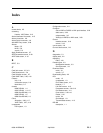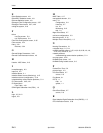
Glossary
8000-A2-GB26-50 April 2001
GL-5
SAR
Segmentation And Reassembly. The function of breaking apart or reassembling packets of
arbitrary size, or the entity that provides this function.
SCM
Shelf Concentration Module. A circuit card that provides connectivity between DSL devices
and an ATM uplink.
SDSL
Symmetric Digital Subscriber Line. A technique for the use of an existing twisted-pair line
that permits high bandwidth, bidirectional transmission.
SN
Service Node. Endpoint modem at the customer premise, also known as a Remote
Termination Unit (RTU). There are several model types. See RADSL, MVL, and SDSL.
SNMP
Simple Network Management Protocol. Protocol for open networking management.
SNMP agent
An application level program that facilitates communication between an SNMP
management system and a device.
See
NMS.
SNMP trap
A message sent to an SNMP manager to notify it of an event, such as a device being reset.
static route
A user-specified permanent entry into the routing table that takes precedence over routes
chosen by dynamic routing protocols.
subnet address
The subnet portion of an IP address. In a subnetted network, the host portion of an IP
address is split into a subnet portion and a host portion using an address (subnet) mask.
This allows a site to use a single IP network address for multiple physical networks.
subnet mask
A number that identifies the subnet portion of a network address. The subnet mask is a
32-bit Internet address written in dotted-decimal notation with all the 1s in the network and
subnet portions of the address.
TCP
Transmission Control Protocol. An Internet standard transport layer protocol defined in
STD 7, RFC 793. It is connection-oriented and stream-oriented.
TCP/IP
Transmission Control Protocol/Internet Protocol. The dominant protocol suite in the
worldwide Internet, TCP allows a process on one machine to send data to a process on
another machine using the IP. TCP can be used as a full-duplex or one-way simplex
connection.
Telnet
Virtual terminal protocol in the Internet suite of protocols. Allows the user of one host
computer to log into a remote host computer and interact as a normal terminal user for that
host.
terminal emulation
Software that allows a PC to mimic the signals of a specific type of terminal, such as a
VT100 or 3270, to communicate with a device requiring that terminal interface.
TFTP
Trivial File Transfer Protocol. A standard TCP/IP protocol that allows simple file transfer to
and from a remote system without directory or file listing. TFTP is used when FTP is not
available.
TraceRoute
A program that lists the hosts in the path to a specified destination.
trap (SNMP)
A notification message to the SNMP manager when an unusual event occurs on a network
device, such as a reinitialization.
UDP
User Datagram Protocol. A TCP/IP protocol describing how messages reach application
programs within a destination computer.
unicasting
In ATM, the sending of a Protocol Data Unit (PDU) to a single destination.
upstream
In the direction of the telephone network.
VNID
Virtual Network IDentifier. In IEEE 802.1Q, a tag that identifies the connection between the
user and the ISP.
WA N
Wide Area Network. A network that spans a large geographic area.





